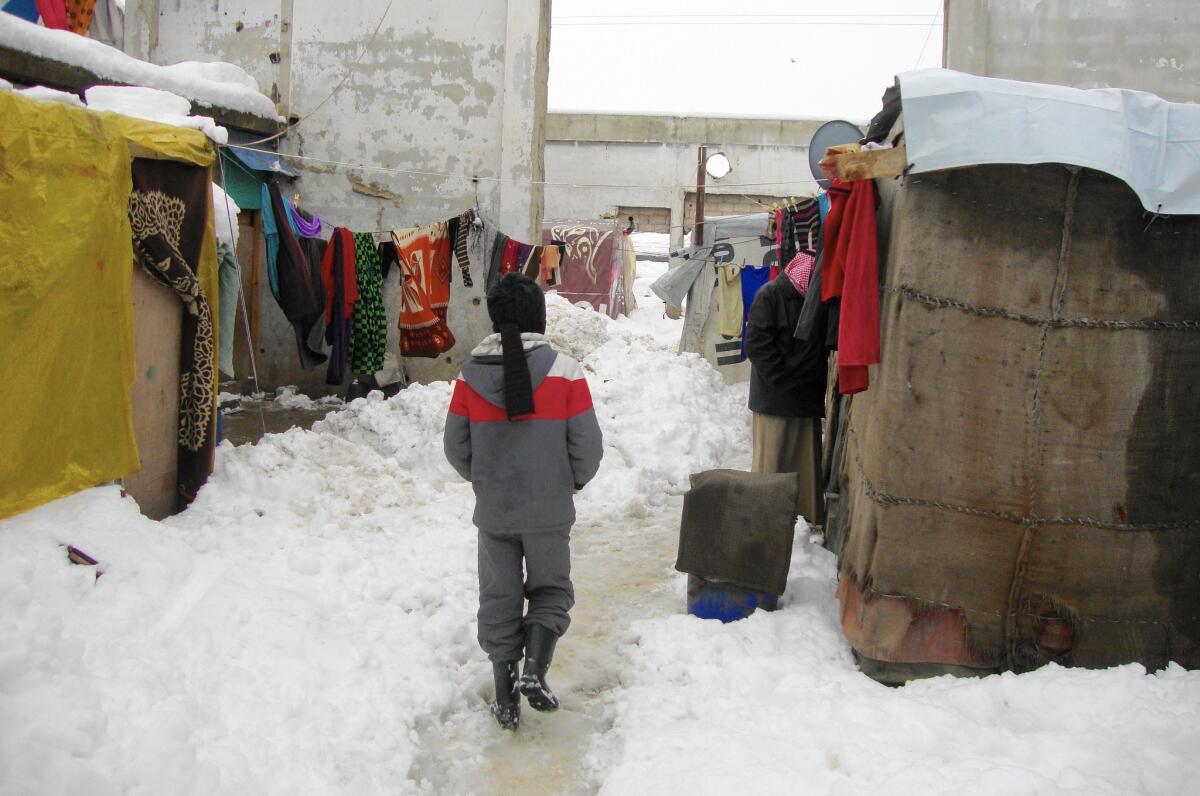Syria refugeesâ lives turn more precarious in Lebanon amid deadly storm

Reporting from CHTAURA, Lebanon â When the snow started falling this weekend, the tail end of a tremendous winter storm that had killed several Syrian refugees in recent days, hundreds of people camped at an abandoned sugar factory here rushed to save their makeshift tents patched with plywood and feed bags.
At 1 a.m. Sunday, after hours of clearing snow, Ahmed Saleh and his family of eight had just ducked inside their tent when, despite their best efforts, the roof began to give way.
âWe started hearing this knocking sound, saw it was swaying and ran out,â Saleh, 45, said.
By 11 a.m., all that was left of their temporary home in Lebanonâs Bekaa Valley was a circle of chairs covered with fresh snow. The family had moved what belongings it could salvage into a one-room tent occupied by Salehâs brother. It must now sleep 15 people â if they ever get a chance to rest.
Five other tents imploded overnight, so some remaining shelters were forced to house three families. And they also were at risk of collapse or flooding during the next storm, expected within hours. Knee-high drifts blanketed surrounding fields, snow covered the mountains and the skies were gray.
âWe havenât slept. The snow just keeps falling,â Saleh said as he stood by others clearing the roads before the expected afternoon onslaught.
The storm has been deadly for refugees across the region.
On Friday, a Syrian woman and her 12-year-old grandson who had fled to Jordan died after inhaling fumes from a gas heater in their apartment, and three relatives were hospitalized in critical condition, officials said. On Wednesday, three Syrians died while trying to cross the border into Lebanon. One was an 8-year-old boy.
More than 3 million Syrians have been forced to flee to neighboring countries since the start of the civil war in 2011, and the refugee crisis has become the worst since World War II. The fourth winter has been brutal for the growing ranks of refugees in Lebanon, which has the greatest share of them and yet no formal camps.
Palestinian refugee camps became a focal point during Lebanonâs civil war, and officials have been loath to create new ones that could alter the delicate balance of political power among Christian, Druze, Sunni Muslim and Shiite Muslim leaders.
The tiny coastal country is home to more than 1.5 million Syrian refugees, more than a quarter of Lebanonâs population. On Monday, officials instituted new visa requirements for Syrians in an effort to slow the stream of refugees, who have become a burden on the economy and the state.
Saleh and his family, like many of their neighbors, fled here months ago from the Syrian city of Raqqah, now one of the capitals of the militant movement Islamic Stateâs self-proclaimed caliphate.
More than 700 refugees live at the abandoned sugar mill, said Ibrahim Uqleh, 57. They are allowed to stay in exchange for working nearby potato fields, leaving them no time to earn wages. They have a single school, with space for 50 students. The rest of the 300 children who live here cannot attend, thereâs no transportation to other schools, and the refugees cannot afford to drive, he said.
The United Nations provides refugees with tent insulation, blankets and other winter supplies as well as monthly support, but the refugees here said they have received little in recent weeks. Their monthly assistance from international aid agencies was recently reduced from $30 to $19.
They receive firewood, but the Lebanese groups delivering it take a cut â 10 of the 150 bags delivered late Saturday. By Sunday morning, Salehâs family had used its two bags of wood to survive the bitter cold.
The campâs outdoor cooking area was snowed in. Water in jugs hanging below some of the communal tanks was frozen. Childrenâs clothes hanging out to dry were covered in snow.
Women and children shoveled paths between their tents, wells and outhouses. Some wore socks with sandals, their heads and hands bare.
Overnight, when the roads were snowed in, a resident went into labor. Mataran Yassin, 35, who has lived here about half a year, gave birth to her fifth child in a tent. It was a boy.
By Sunday morning, Yassin still had yet to name the baby. She was too busy keeping the rest of her family warm.
âThis winter is particularly difficult,â she said as her children flitted around her in their dark, smoky tent. âWeâre always keeping the heater on and using fuel.â
Outside, Nashmiyeh Karbo, 45, was shoveling snow from her temporary doorstep, wearing only a purple velour dress, black head scarf and flats to protect against the wind. Her 3-year-old son tried to help, his nose running as he hefted a shovel bigger than he was and chipped away at the icy path.
He was one of the lucky ones: He had a hat.
âWeâve really gotten it bad this winter,â his mother said. âAll this snow and this cold. We need everything: food, clothes, blankets.â
Karbo said support from the United Nations and others has been scarce. âWe got two blankets, but I have 11 children, so itâs hardly enough,â she said.
Like Saleh, she had spent the night clearing snow from the top of her tent so that it wouldnât collapse. So far, she had succeeded.
She returned to shoveling as a bitter wind picked up and clouds gathered overhead.
Bulos is a special correspondent.
Twitter: @mollyhf
More to Read
Sign up for Essential California
The most important California stories and recommendations in your inbox every morning.
You may occasionally receive promotional content from the Los Angeles Times.











